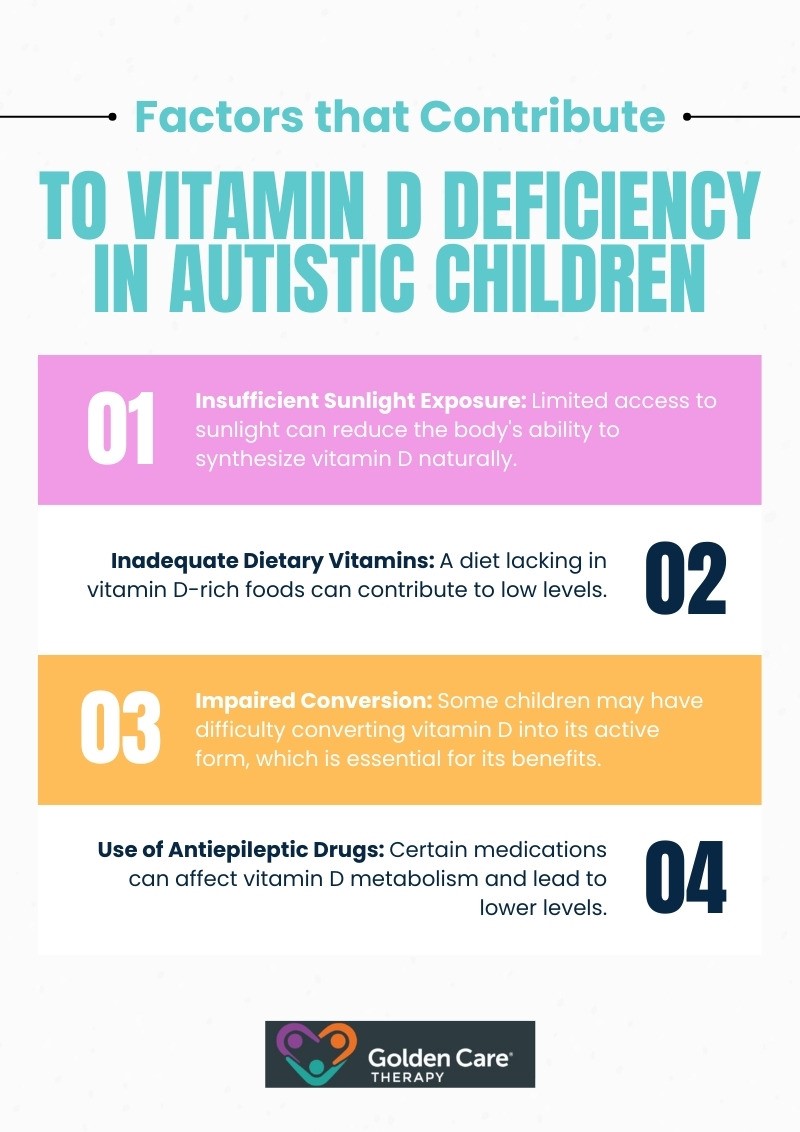Vitamin D deficiency is a significant concern in children with autism. Research reveals that autistic children consistently report significantly lower levels of vitamin D compared to their typically developing peers. This deficiency can have various implications for their overall health and development.
Studies also reveal that children who are, or who are destined to become, autistic have markedly lower levels of 25-hydroxyvitamin D [25(OH)D] at multiple stages: at 3 months of gestation, at birth, and by age 8, compared to their unaffected siblings.
This trend of lower vitamin D levels raises awareness about the nutritional needs and health management of children with autism.
Statistically, a staggering 63.8% of children diagnosed with autism are found to have vitamin D insufficiency. This statistic underscores the crucial importance of monitoring vitamin D levels in children with autism for their parents and caregivers.
It’s worth mentioning that vitamin D plays a pivotal role in many bodily functions, including immune system regulation and bone health. Understanding the relationship between vitamin D levels and autism is crucial for developing effective management strategies.
As parents and caregivers navigate the complexities of autism, awareness of vitamin D’s importance becomes crucial for promoting better health outcomes.
Importance of Vitamin D in Autistic Individuals
Vitamin D plays a crucial role in modulating the inflammation system, which is particularly relevant for children with autism. It regulates the production of inflammatory cytokines and immune cells, key components that are essential for the pathogenesis of immune-related diseases, often associated with autism.
Research indicates that autistic children may experience higher levels of inflammation, which can worsen symptoms. Vitamin D’s ability to modulate inflammation offers a potential pathway for mitigating some of these symptoms.
In essence, the effects of vitamin D on inflammation and immune response include the following:
- Modulates the production of inflammatory cytokines
- Influences immune cell maturation and activity
- Affects the overall inflammatory response in the body
Furthermore, vitamin D may be linked to various biological processes that could impact brain health. It is believed to influence brain homeostasis, embryogenesis, neurodevelopmental immune modulation, antioxidants, anti-apoptosis, neural proliferation, and gene regulation.
This wide-ranging impact highlights the importance of adequate vitamin D levels during critical periods of development in children.
Overall, understanding the role of vitamin D in inflammation regulation provides insight into its potential benefits for children with autism. Maintaining appropriate vitamin D levels may be essential for supporting immune function and possibly alleviating some symptoms associated with autism.
Impact of Vitamin D on Autism Symptoms
Vitamin D can play a significant role in managing certain autism symptoms.
Research suggests that vitamin D may increase the threshold for seizures in children. For those with autism who also experience epilepsy, this is particularly relevant. By potentially helping to control the occurrence and severity of seizures, adequate vitamin D levels may provide some children with improved stability and overall well-being.
Moreover, children with autism spectrum disorder who are deficient in vitamin D often demonstrate disrupted serotonin levels in the brain. Serotonin plays a vital role in regulating various brain functions, including mood, behavior, and emotional cues. Inadequate vitamin D can negatively influence serotonin levels, which in turn can affect social behavior and emotional responses in autistic children.
The connection between vitamin D and serotonin underscores the importance of maintaining sufficient vitamin D levels for children with autism. By addressing vitamin D deficiency, there may be a positive impact on both seizure management and emotional regulation within this population.
There have been lots of vitamin D supplementation trials that indicate that improving vitamin D status can significantly reduce the severity of autism symptoms. However, results have shown variability, with differences between treatment and control groups not always being consistent.
This may be attributed to variations in vitamin D dosage protocols and the potential influence of concurrent interventions.
As such, determining the optimal dosage of vitamin D for children with autism is essential for effective treatment and preventive measures. Recommendations suggest specific dosages based on varying objectives:
- 300 IU/kg/day of vitamin D is advised for treating autism symptoms.
- Pregnant and lactating women are recommended to take 5000 IU/day, while infants and young children should receive 150 IU/day.
Regular monitoring of vitamin D levels is also important. It is suggested to check 25(OH)D levels every three months to ensure achievement of the recommended blood levels as outlined by the Endocrine Society.
Understanding the efficacy of vitamin D trials and adhering to recommended dosages are important steps for parents and caregivers seeking to manage the health of children with autism effectively.
Factors Affecting Vitamin D Levels
Understanding the factors that contribute to vitamin D deficiency is crucial, especially for children with autism. Several elements can influence vitamin D levels in these children.
Several factors lead to serum vitamin D deficiency and insufficiency in children with autism. Some of the key contributors include:

These factors can significantly impact the vitamin D status of children with autism, underlining the importance of monitoring and intervention.
At the same time, vitamin D may act as an environmental risk factor for autism, influencing many neurodevelopmental processes. Here are some important environmental aspects to consider:
- Brain Homeostasis and Development: Vitamin D plays a role in brain function, embryogenesis, and neurodevelopmental immune modulation.
- Gene Regulation: Vitamin D influences the regulation of genes linked to development and brain health.
- Antioxidants and Anti-Apoptosis: Its presence is essential for antioxidant functions, which protect cells from damage.
Research indicates that children who are, or who may become, autistic have lower 25(OH)D levels at three months of gestation, at birth, and at age eight compared to their unaffected siblings. This finding highlights the potential importance of maintaining adequate vitamin D levels during key developmental stages.
In vitamin D supplementation trials, improvements in vitamin D levels were associated with a significant reduction in the severity of autism symptoms. However, awareness of safe supplementation practices is vital.
Over the past 15 years, Poison Control has reported about 15,000 cases of vitamin D overdose, though clinical toxicity has been rare, with no fatalities documented.
The interplay of these factors can affect the vitamin D status in children with autism, emphasizing the need for vigilant monitoring and possible intervention.
Conclusion
Vitamin D plays a vital role in the health and development of children with autism. From regulating inflammation and supporting brain development to influencing mood and seizure activity, its impact is far-reaching.
While vitamin D supplementation has shown promise, finding the right dosage and monitoring levels regularly is key. At Golden Care Therapy, we go beyond just addressing physical health, as we also tailor every aspect of our ABA therapy to support your child’s overall development.
Our dedicated team offers high-quality, compassionate care from a skilled ABA therapist in Indiana, New Jersey, New York, Georgia, and Florida to ensure your child receives consistent and personalized support. If you’re ready to take the next step, contact us today to learn how we can help your child thrive.
Sources:



